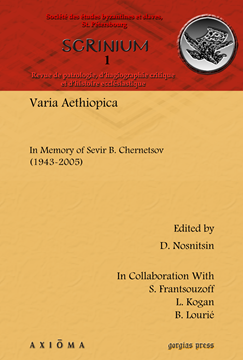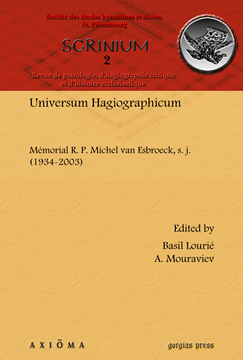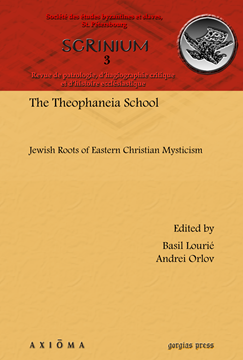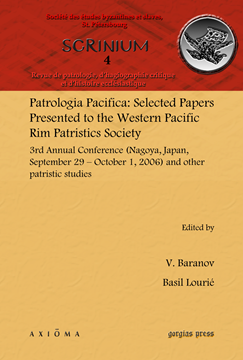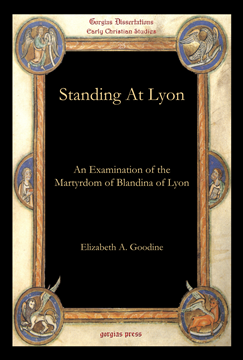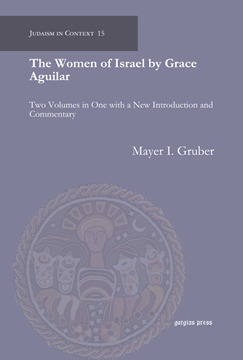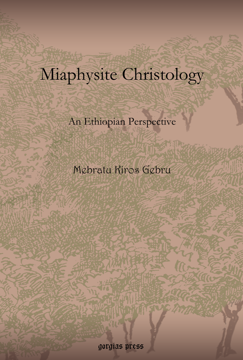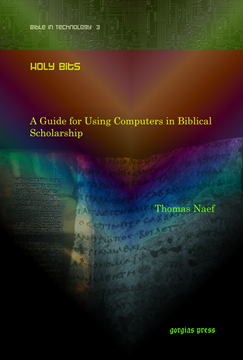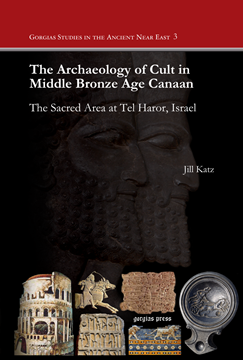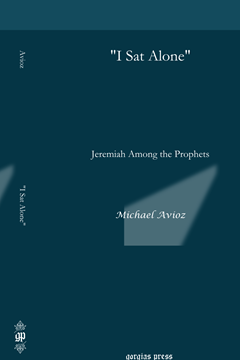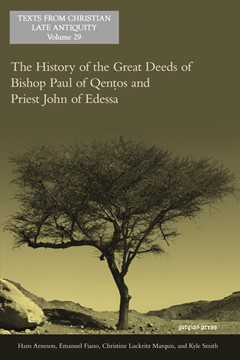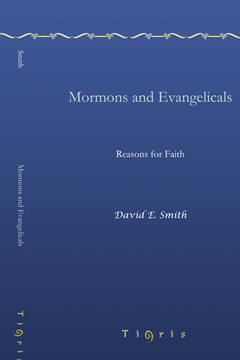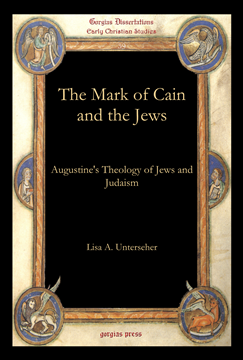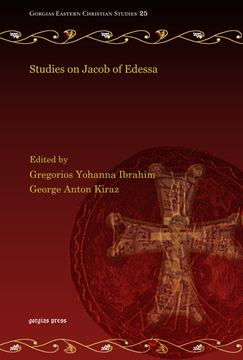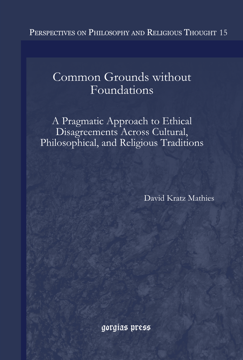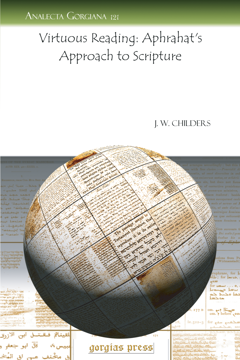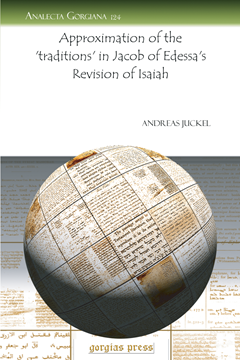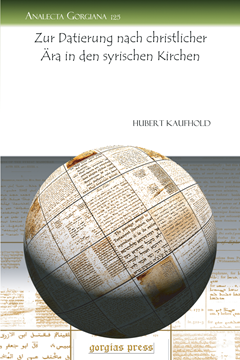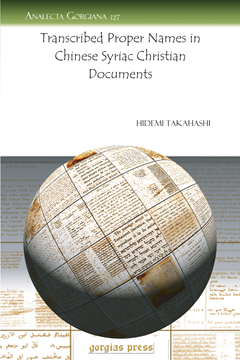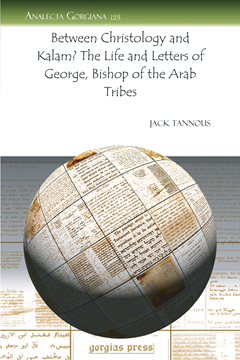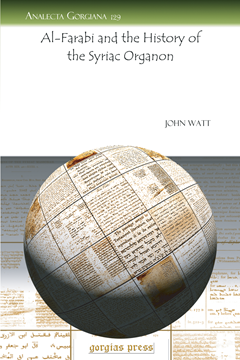The Spell of the Logos
Origen’s Exegetic Pedagogy in the Contemporary Debate regarding Logocentrism
Series: Gorgias Eastern Christian Studies 10
ISBN: 978-1-59333-698-1
Origen’s construal of the Bible as a textual incarnation of the Word encourages an assimilationist interpretation of the Hebrew Scriptures as a proto-Christian gospel. Although in partial agreement with this thesis, this study suggests a non-assimilationist reading of Origen’s biblical exegesis.
$241.00 (USD)
Varia Aethiopica
In Memory of Sevir B. Chernetsov (1943–2005)
ISBN: 978-1-60724-081-5
Scrinium: Revue de Patrologie, d’Hagiographie Critique et d’Histoire Ecclésiastique, established in 2005, is an international multilingual scholarly periodical devoted to patristics, critical hagiography, and Church history. This volume is dedicated to Ethiopian Christianity and Ethiopian linguistics.
$195.00 (USD)
Universum Hagiographicum
Mémorial R. P. Michel van Esbroeck, s. j. (1934–2003)
Edited by Basil Lourié & A. Mouraviev
ISBN: 978-1-60724-082-2
Scrinium: Revue de Patrologie, d’Hagiographie Critique et d’Histoire Ecclésiastique, established in 2005, is an international multilingual scholarly periodical devoted to patristics, critical hagiography, and Church history. This volume is dedicated to the memory of R. P. Michel van Esbroeck who studied hagiography of the Christian East and West. However, in keeping with van Esbroeck's broad academic interests, the volume explores other areas of patristics as well.
$219.00 (USD)
The Theophaneia School
Jewish Roots of Eastern Christian Mysticism
Edited by Basil Lourié & Andrei A. Orlov
ISBN: 978-1-60724-083-9
Scrinium: Revue de Patrologie, d’Hagiographie Critique et d’Histoire Ecclésiastique, established in 2005, is an international multilingual scholarly periodical devoted to patristics, critical hagiography, and Church history. This volume is dedicated to Jewish Second Temple and early Christian mysticism.
$215.00 (USD)
Selected Papers Presented to the Western Pacific Rim Patristics Society
3rd Annual Conference (Nagoya, Japan, September 29 – October 1, 2006) and other patristic studies
Edited by Vladimir Baranov & Basil Lourié
ISBN: 978-1-60724-084-6
Scrinium: Revue de Patrologie, d’Hagiographie Critique et d’Histoire Ecclésiastique, established in 2005, is an international multilingual scholarly periodical devoted to patristics, critical hagiography, and Church history. This volume contains a partial publication of the papers of the 3rd Conference of the Asian Pacific Early Christian Studies Society which was focused on patrology, with special attention paid to patristic biblical interpretation.
$217.00 (USD)
Standing At Lyon
An Examination of the Martyrdom of Blandina of Lyon
ISBN: 978-1-59333-895-4
The suffering woman, Blandina, emerges as an archetypal figure of the martyrs of Lyon. This slave-woman ultimately arises to engage in battle with the powers of the Roman Empire. Through the application of Bowen Family Systems Theory and the writings of Michel Foucault the book explains the function of anxiety, and the dynamics at work in the system that result in the failure of Roman authority to use power to quell the rise of Christianity. The reactions of those who might appear to be the most powerful are essential in gifting power to this lowly slave.
$148.00 (USD)
The Women of Israel by Grace Aguilar
Two Volumes in One with a New Introduction and Commentary
Series: Judaism in Context 15
ISBN: 978-1-61719-626-3
For almost a century after it was first published in 1845 Grace Aguilar's Women of Israel was presented as a high school graduation gift and even as a Christmas present to employees. More than 150 years before the current proliferation of books on women in biblical narrative and biblical law, Aguilar offered brilliant and innovative interpretations of abiding value. She took for granted that her readers could read Hebrew and that they, like herself, knew the King James Bible from memory. The extensive introduction and notes will make this new edition once again accessible to laypersons, students, and scholars.
$346.00 (USD)
Miaphysite Christology
An Ethiopian Perspective
ISBN: 978-1-60724-528-5
As in the case of the christology of the other non-Chalcedonian Oriental Orthodox Churches, Ethiopian christology is usually nicknamed as monophysite christology - an erroneous christological position which indicates the absorption of the humanity of Christ by its divinity. Disproving such a pejorative designation, this book contends that the christological position of the Ethiopian Orthodox Tewahedo Church should correctly be termed as miaphysite christology, which highlights the one-united nature of the Word of God incarnate. Besides, the book proves the orthodoxy of Ethiopian christology, demonstrating how it is based on the christology of St. Cyril of Alexandria.
$123.00 (USD)
Holy Bits
A Guide for Using Computers in Biblical Scholarship
By Thomas Naef
ISBN: 978-1-60724-327-4
This book is an excellent resource for students, scholars, pastors and other people interested in biblical studies for their daily work at the computer. This book treats general interest subjects like hardware and networks, operating systems, word processors and others. The main focus is on subjects for biblical scholars like Unicode, bible software and websites. Each chapter ends up with a list of URLs for further information about the subject. An online up-to-date link list is available. It can be used as textbook as well as a reference work.
$130.00 (USD)
The Archaeology of Cult in Middle Bronze Age Canaan
The Sacred Area at Tel Haror, Israel
By Jill Katz
Series: Gorgias Studies in the Ancient Near East 3
ISBN: 978-1-59333-791-9
What was Canaanite religion like during the Middle Bronze Age, at the time of the biblical patriarchs? This volume presents a theoretical model for identifying ritual behavior in the archaeological record, providing a test case using the rich material culture and structures that have been unearthed at the biblical city of Gerar (Tel Haror, Israel).
$149.00 (USD)
“I Sat Alone”
Jeremiah Among the Prophets
ISBN: 978-1-59333-854-1
The prophet Jeremiah is among the most complex and intriguing characters in the Bible. This study of the prophet focuses on the major biographical episodes in the prophet’s book and their interpretation. After setting the historical background of the prophet, Avioz then explores Jeremiah’s prophetic call. All major events of his life are parsed for a deeper insight into the prophet's life. Those with whom Jeremiah interacts, the kings of Judah and the false prophets, are assessed in contrast with the prophet. Avioz concludes his study with a consideration of Jeremiah’s legacy down to the present day.
$84.00 (USD)
The History of the Great Deeds of Bishop Paul of Qentos and Priest John of Edessa
Series: Texts from Christian Late Antiquity 29
ISBN: 978-1-60724-670-1
Desiring to lead an ascetic life during the 5th century, Paul abandons his bishopric in Italy and travels to Edessa. John realizes that Paul is a wonderworker, and so begs to accompany him on his travels. The two leave Edessa to visit the monks on Sinai, but instead of reaching their destination they are abducted and taken to Yemen by tree-worshipping Arabs. After a battle with a tree-god, they succeed in converting the Arabs to Christianity. During the journey home, they encounter a wandering band of monks among whom is a woman disguised as a man.
$38.00 (USD)
Dischronology and Dialogic in the Bible’s Primary Narrative
Series: Biblical Intersections 2
ISBN: 978-1-60724-105-8
This ground-breaking study offers a reassessment of Moses' book of the law from a narrative theory perspective. Concerned for the long-term viability of his people, Moses legislates a public reading of his document which is deposited next to the ark of the covenant as a national testament. Through the mechanics of narrative mediation, the narrator reveals to the reader of Deuteronomy the contents of Moses' enshrined publication. Deuteronomy's simulcast of Moses' book invites external readers to compare and evaluate their readings with story-world readers who access the same text within the Bible's Primary Narrative.
$141.00 (USD)
Mormons and Evangelicals
Reasons for Faith
ISBN: 978-1-60724-027-3
Why do religious people believe? In this work, Smith describes and interprets the results of interviews conducted with Mormons and Evangelicals about their reasons for faith. In the end, he recommends a particular approach to faith that integrates the sociological, spiritual, and rational elements of religion.
$65.00 (USD)
The Mark of Cain and the Jews
Augustine’s Theology of Jews and Judaism
ISBN: 978-1-59333-896-1
This book examines the development of Augustine of Hippo’s theology of the Jewish people and Judaism. Formulating a typological association between the biblical figure of Cain and the Jews, he crafts a highly intricate theology that justifies and even demands the continuing presence of Jews and their religious practices in a Christian society. Such a theology emerges out of his highly original interpretation of Genesis 4:1–15 and yet mirrors and theologically justifies the reality of Jews and Judaism in the late Roman Empire.
$136.00 (USD)
The Ostraca of the Coptic Museum in Old Cairo, Egypt
Compiled by S. Kent Brown
Series: Gorgias Handbooks 13
ISBN: 978-1-60724-014-3
The Ostraca of the Coptic Museum, written on pottery pieces, limestone flakes and wood, present the lives of ordinary people in their interactions with one another, and includes their economic and personal affairs. This volume is a catalog of the 1,127 ostraca in the museum.
$179.00 (USD)
Studies on Jacob of Edessa
Edited by Gregorios Yohanna Ibrahim & George Anton Kiraz
Series: Gorgias Eastern Christian Studies 25
ISBN: 978-1-60724-997-9
Jacob of Edessa was a seventh century polymath who witnessed the coming of Islam. In this collection of papers, specialists discuss the life and works of this figure with emphasis on the cultural landscape of the seventh century. Contributors include Sebastian P. Brock, Richard Price, Andreas Juckel, Alison Salvesen, Theresia Hainthaler, Amir Harrak, and Khalid Dinno.
$163.00 (USD)
Enlivening the Past
An Asian Theologian’s Engagement with the Early Teachers of Faith
Series: Gorgias Précis Portfolios 3
ISBN: 978-1-60724-103-4
This collection of essays offers an innovative exploration by an Asian theologian on various issues and themes that engaged the early teachers of faith. It gives special focus to the ongoing relevance of these issues for Christian theological discourse and praxis today.
$131.00 (USD)
Common Grounds without Foundations
A Pragmatic Approach to Ethical Disagreements Across Cultural, Philosophical, and Religious Traditions
ISBN: 978-1-60724-042-6
An alternative, fallibilist model of moral reasoning rooted in the American Pragmatic tradition. Additional resources drawn from Chinese philosophy, Jain epistemology, modern philosophy of mathematics, and the Gadamerian hermeneutical tradition serve both to corroborate the argumentation and to provide examples of continuities in reasoning that cross the boundaries of disparate traditions.
$177.00 (USD)
Virtuous Reading
Aphrahat’s Approach to Scripture
Series: Analecta Gorgiana 121
ISBN: 978-1-60724-035-8
The epistemology of the mid-fourth-century Christian scholar in Persia, Aphrahat, presumes that the human mind and the task of biblical interpretation are caught up in a dynamic experience of Christian spiritual transformation. In short, for the Persian Sage, good Bible interpretation requires nothing less than the total person—inner and outer, in community and before God. In Aphrahat’s Demonstrations, we encounter a scholar who not only presents this remarkably integrated set of ideals but is also an impressive practitioner of them.
$37.00 (USD)
Approximation of the ‘traditions’ in Jacob of Edessa’s Revision of Isaiah
Series: Analecta Gorgiana 124
ISBN: 978-1-60724-036-5
This article contributes to the knowledge of Jacob of Edessa’s (d. 708) Old Testament revision by editing twenty texts (a total of 80 verses) from the Book of Isaiah and comparing them with the Greek recensions of the Septuagint, with the Peshitta, and the Syrohexapla. Two special features are introduced to set out Jacob’s revision technique in some detail: 1. comparison with an earlier undeveloped stage of Jacob’s revision extant in Ms Add 17,134 of the British Library; and 2. the distinction (by different colours and fonts) of the ‘traditions’ involved in the definite stage of his revision. Both features point to the emphasis given to the Peshitta in translating the substantial Greek text of the Old Testament.
$43.00 (USD)
Zur Datierung nach christlicher Ära in den syrischen Kirchen
Series: Analecta Gorgiana 125
ISBN: 978-1-60724-038-9
The Christian era in Syriac and Arabic sources does not always correspond with the western calculations. Until quite recently the members of the Syriac churches used the era of the Seleucids (of Alexander the Great; East and West Syrians) as the era of the creation of Adam (Melkites). The use of the Christian era became more common from the 16th century, due to the closer contacts between the Oriental and the Latin churches.
$43.00 (USD)
Transcribed Proper Names in Chinese Syriac Christian Documents
Series: Analecta Gorgiana 127
ISBN: 978-1-60724-039-6
Christianity reached China in its Syriac guise in the seventh century. Christian documents written in Chinese which have come down to us from the period of the Tang Dynasty contain a large number of proper names which are, or appear to be, transcriptions of Syriac names. In this paper, originally published in Malphono w-Rabo d-Malphone: Studies in Honor of Sebastian P. Brock, the author provides a list of the transcribed proper names with their modern and reconstructed Middle Chinese pronunciations, together with the suggestions made by scholars in the past for the original forms of these names.
$38.00 (USD)
Between Christology and Kalām? The Life and Letters of George, Bishop of the Arab Tribes
By Jack Tannous
Series: Analecta Gorgiana 128
ISBN: 978-1-60724-040-2
A translator of Aristotle and friend of Jacob of Edessa and Athanasios of Balad, George, Bishop of the Arab Tribes (d. AD 724) was an important figure in the history of the life and thought of the Syrian Orthodox Church. This article offers a study of the first three of George’s eleven extant letters and relates them to the larger Christian and Islamic context of his day. It will be of interest to students of Greek patristics, Syriac Christianity, and early Islamic history.
$41.00 (USD)
Al-Farabi and the History of the Syriac Organon
By John Watt
Series: Analecta Gorgiana 129
ISBN: 978-1-60724-041-9
Scholarly study of the transmission of Aristotelian philosophy from Greek late antiquity to medieval Islam is to some extent still influenced by the account in Ibn Abī Uṣaibi‛a attributed to al-Fārābī, which served as the basis for Max Meyerhof’s famous essay Von Alexandrien nach Bagdad. The present work, utilising evidence unknown to Meyerhof and still often neglected in more recent scholarship, argues that such a restriction never represented the whole Syriac tradition, but reflects an alternative logical curriculum with deep roots in the ancient world, while Syriac writers who were proficient in Greek adhered throughout to the other strand of this two-strand tradition, that of the full Organon.
$37.00 (USD)

